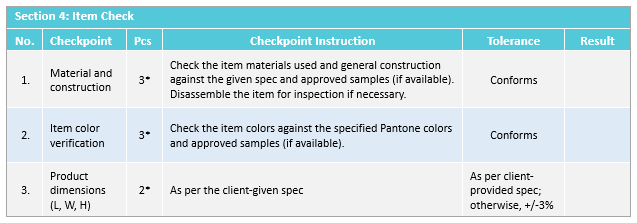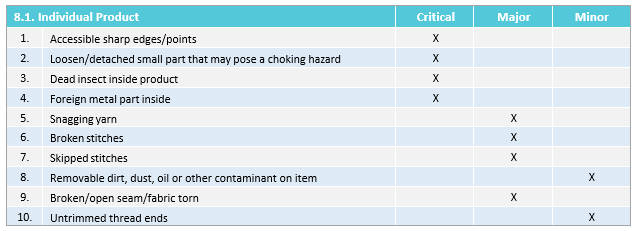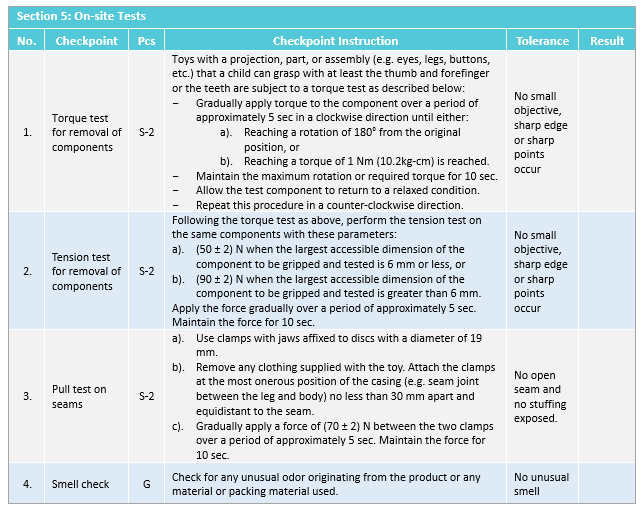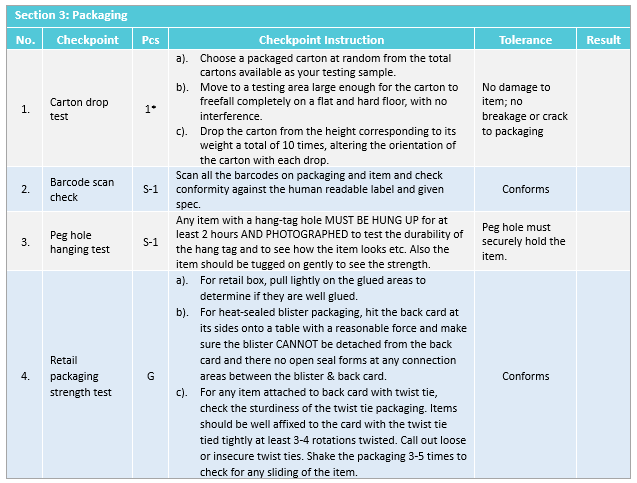 Who would rather decide whether production units meet your requirements: you or factory workers?
Who would rather decide whether production units meet your requirements: you or factory workers?
Almost all importers would say they are a better judge than their supplier. After all, they’re the ones paying for the goods. And there’s a conflict of interest for factory staff to develop the quality manuals used to evaluate the quality of their own work.
Factories should certainly have their own internal quality documents to carry out QC processes importers often leave up to their supplier, like incoming quality control of raw materials. But factory staff might omit important checkpoints they’re afraid they can’t pass. Or they might make assumptions about the products or fail to catch issues due to a self-assessment bias.
And they might not be aware of an importer’s requirements for a particular order, as these standards and requirements often vary among buyers. There might be numerous different ways to manufacture the same product with different materials, components, specifications and quality standards. It’s not fair to expect factory workers to read your mind when it comes to your specific product requirements.
Your quality manual, or checklist, is the best place to represent your priorities and interests for both factory staff and QC inspectors (related: 5 Essentials of a QC Checklist [eBook]). Let’s compare two actual quality manuals for the same product—one from a factory and one from professional QC staff— and explore how to ensure no product requirements are missing in action for your next order.
Do factory staff know your tolerances for quality defects?
Factory QC manuals sometimes lack clearly defined and measurable quality standards. Instead, quality is judged on a subjective “good” or “bad” basis, without accounting for a spectrum of quality standards or tolerances.
Take a look at the following excerpt for evaluating material quality for a plush toy intended for the EU market.![]()
There’s no mention of how to measure or evaluate quality issues in the product material. Are factory managers likely to discard 100 percent of materials with quality issues? Probably not, and they might not need to if they can salvage parts or materials or if quality issues found aren’t significant. But without clear definitions of what is acceptable or not, the decision is left to workers’ own subjective judgement.
For instance, there’s obviously a major color difference between red and yellow fabric. But what about the difference between fabric that’s a light shade of yellow and another that’s a slightly darker shade of yellow?
Professional QC documents often require inspectors to use a Pantone swatch to accurately compare a product’s color against a specification. Inspectors may even rely on more sophisticated equipment, such as a lightbox, for greater precision. It can also be helpful to compare a production sample with an approved sample to ensure compliance with your standard.
Most professional quality manuals will also include tolerances for issues for that have a range of acceptable values. For instance, it’s common to set a plus-minus percentage tolerance for measurements, both of consumer products like garments and industrial products and parts.
Tolerances help importers judge the severity of quality issues and determine whether any rework is required or whether a slight difference is acceptable.
Classifying quality defects in your quality manual using AQL
A professional checklist should also include a table clearly classifying almost all possible quality issues as critical, major or minor defects. These classifications are vital to determining the overall inspection result using AQL. Importers often set a tolerance for how many defects of each type they’ll accept in the shipment.
How can failing to notify your QC team of your tolerance for quality issues before inspection affect your product quality?
Without a clear understanding of which defects are acceptable, inspectors might be too lenient or too strict in reporting on your products. You may be unable to interpret results and forced to schedule a re-inspection to get clarity.
Or worse, the results could be inaccurate, leading you to make a misguided shipping decision based on false information. You could end up losing customers because you mistakenly approved a shipment of mostly substandard goods (related: 3 Mistakes Importers Make with Quality Control Checklists).
Third-party inspection companies typically classify defects based on their experience with similar product types and legal requirements relevant to the intended market. Your own tolerance for quality issues might vary from industry standards based on your target market or price point.
While this information is most helpful during inspection, it’s also crucial to send this specification to your factory ahead of production (related: 4 People to Consult When Creating a Quality Manual for Your Product). Many importers face delays because factory workers need to rework a large number of defects (that could have been prevented) before they can ship the goods.
Do on-site testing procedures adequately evaluate product performance and safety?
On-site testing is important for simulating real-world product use and determining the functionality, safety and durability of products.
But tests performed incorrectly can give you false results and false assurance of your product quality. Product quality issues can catch you unaware when the product doesn’t perform as intended. And you might not discover these issues until you receive an order of goods or consumers complain after actually trying to use your product.
Product tests are further complicated when there are multiple ways to perform the same test, using different equipment, testing methods or standards. These are all great reasons to outline on-site testing in your quality control manual.
Factory staff typically conduct some product testing during production, especially for products with a specific function or number of functions, like a smartphone. But even this quality manual for plush toys, a product far less complex than a smartphone, includes some on-site testing.
There are some positive features of the on-site testing section of this factory’s QC manual. It indicates the overall international standard the product needs to comply with, EN71, and the standard for each on-site test. But this section leaves out critical information related to:
- Sample size: Should the inspector conduct the test on 100 percent of units, the full sample size or a smaller, special inspection level?
- Procedure: What equipment should QC staff use for the test? How long should the inspector conduct the test on each unit to come to a reliable result?
- Other critical tests: Plush toys with removable parts should be subjected to a torque test, in addition to a tension pull test.
Specifying sample sizes for on-site tests in your quality manual
Factory QC documents are often structured with internal QC and production procedures in mind, not a pre-shipment inspection using random sampling. Factory quality manuals often don’t include inspection sampling procedures or sample sizes. In contrast, quality manuals QC professionals create typically contain these details, as shown in the below table under “pcs” for pieces.
Clear sampling protocols are essential to determining the scope of inspection and ensuring inspectors check a representative sample of your order. You may want to adjust sample sizes for tests that:
- Are time-consuming to perform, such as charge/discharge testing for battery-powered electronics
- Are destructive to the product, such as fabric composition testing, or
- Are likely to yield similar results across all units, such as load testing for an item of furniture
Choosing the right sample size for each test for your product will get you the valuable information you need, without having your inspection budget spiral out of control with time-consuming tests.
You’ll see the sample sizes for the tension test, torque test and seam strength test outlined above are all “S-2”, referring to a special inspection level on the AQL table. That’s because each test takes at least 15 seconds to perform, not to mention the time to set up equipment and record results.
Fifteen seconds might not seem like a long time. But imagine performing this test on 125 units—this would total over 30 minutes for just one test! And these components are often adhered using the same processes, so the testing results are likely to be consistent across units.
In comparison, the sample size for the smell check is G, referring to a general inspection level. Inspectors will perform this check on a much larger sample mainly because they can usually detect unusual odors easily and quickly. So it’s feasible to check all units in this main sample size.
Setting expectations for required testing equipment and who should provide it
Independent inspectors often only carry small, portable equipment with them to the inspection site, such as calipers or a moisture meter. And certain tests often require more sophisticated equipment that inspectors must rely on the factory to provide. Inspectors can’t perform such tests if factory staff don’t know to provide the appropriate equipment (related: How Product Inspectors Use Quality Control Checklists).
 The result could be that you can’t determine the quality level of a shipment because certain test results are missing.
The result could be that you can’t determine the quality level of a shipment because certain test results are missing.
Equipment isn’t always testing equipment like pull gauges, scales or electrical testers. For products intended to work with other products, you might also need to ensure these complementary items are available. For instance, if you’re manufacturing a mobile phone to be compatible with SD, miniSD and microSD memory cards, you’ll need to ensure all are available on the day of inspection for testing.
Establishing required on-site tests and procedures ahead of inspection also ensures factory staff are aware of all necessary equipment they need to provide. And while factory quality control manuals often assume these details, most professional QC manuals will include them explicitly.
Have factory staff overlooked packaging requirements in their quality manual?
Factories, and even importers, often focus on the products themselves and overlook packaging details when attempting to manage product quality. But any number of problems can happen during shipping when you neglect packaging quality, including:
- Crushing of packaging materials and products due to use of improper stacking methods, packaging assortment or materials
- Water damage or packaging or product warping due to poor sealing or storage of packaging materials
- Seizure or delay of products at customs or your retailer’s warehouse due to improper labeling or assortment
Packaging checks of all packaging elements, including shipping cartons, retail packaging, packaging assortment and labeling can help prevent such issues from occurring (related: Packaging Inspection Guideline [eBook]). Let’s check whether the factory’s quality control manual adequately addresses packaging concerns.
The factory’s QC checklist mostly focuses on ensuring the products are packed well and assorted correctly. This is an essential part of packaging inspection. And it’s particularly important for helping importers keep track of inventory levels and ensure the right SKUs and quantities of products arrive where intended. Checking polybag thickness also helps confirm compliance with packaging regulations for many markets and retailers.
But this factory quality manual is missing an important part: on-site testing to ensure the strength and durability of packaging materials and methods.
Addressing on-site testing for packaging materials and methods in a quality control manual
Factory managers might not willingly include on-site packaging tests in their quality manual, as these tests can sometimes damage products or packaging materials. The factory might need to produce additional units or acquire new packaging materials to replace tested units, narrowing their profit margins or extending their production time.
But on-site tests, like the carton drop test, are essential to ensure the strength of packaging materials and security of your products. Professional quality manuals will include on-site tests to check the strength and durability of shipping cartons and retail packaging. As you’ll see below, the procedures for on-site testing will vary based on the type of packaging materials you’ve used.
You can even go a step further and conduct lab testing for packaging at an off-site laboratory to check the strength of cardboard shipping cartons.
Barcode scan checks and labeling inspection are especially useful for importers shipping products direct to retailer warehouses. Some retailers have specific labeling and packaging requirements and charge fees for noncompliance, like Amazon FBA. With Amazon raising inventory fees for U.S. sellers in 2018, you might not be able to afford added charges for labeling or assortment issues with your inventory.
Importers often send digital copies of their shipping labels to inspectors to check compliance on site. You might also consider sending a photo or diagram of how the label or retail packaging should be applied to ensure it’s readable, convenient and properly placed.
Conclusion
If this is your first time developing a quality manual for your product, third-party inspection companies can help you using industry standards and knowledge.
All importers have different requirements and needs. So focus on creating a quality manual that fits your unique requirements, rather than relying on the factory’s quality manual alone. In particular, when it comes to identifying and classifying quality defects, conducting on-site performance and safety tests and verifying packaging, a factory’s quality manual might be insufficient.
It’s not always feasible, nor reasonable, for importers to inspect their own products. But even if you’re not on site at the factory, you can still have a lot of control over product quality—so long as you prepare ahead of time.
Ready to get started drafting a quality manual for your product now? Download our free eBook below to find out what other vital information you should include in your quality manual!







